Ron Ludekens
Chilling Hours
Question: Fruit trees require a certain amount of "chill hours" to produce fruit. What exactly is a "chill hour" ? Below what temperature is considered a chill hour?
Joan - Magnolia Texas
Answer: Hi Joan,
Let me point you to another post that may answer your question: Chill Hours
Ron L.
Making Up Lost Time
It's Sunday morning and this is a nice sight:

Loaded trucks ready to roll (6 photo panorama stitched together - the original photo is huge)
A week ago at noon on Saturday we completed harvest. After the 30 minute lunch break, we started to pull orders to load trucks. And yes it was a scramble in the office to complete prorates, print pull sheets and get the first line up to the shipping yard in such a short time.
Due to the weather challenges, we started loading trucks 10 days later than our goal of December 29th. All our promised ship dates are predicated upon starting on time. Needless to say, we were late and not making happy customers (except those who had their own weather problems).
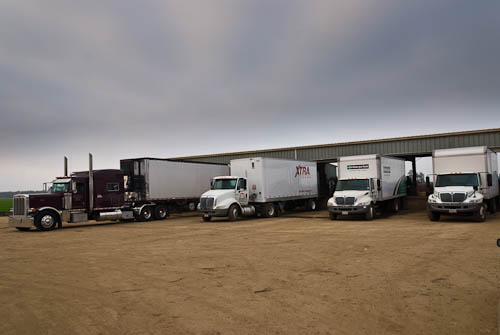
Trucks being loaded late Saturday afternoon
How do you make up 10 days? Realistically, you can't. But we came close. What you see here is the last of the 1st and 2nd week promised shipments and a big start of the 3rd week shipments. With the trucks we will load tomorrow (Monday), we will have delivered or on the road all the early shipments plus shipping the rest of the orders on time. In other words, we shipped two weeks worth of products in 8 days!
It is Sunday - a day of rest (at least for all but a few of us). Next Sunday I plan to be back in church too in my normal place running the PowerPoint for the services. The field/shipping workers finally have a day off - a well earned rest after several weeks of continuous labor - late into each night. All the trucks were loaded by Saturday night. Payroll costs took a hit making it happen. Overtime and double overtime to get it caught up. We truly take our commitment to our customers seriously and are grateful most of our customers understood the challenge. Yep - you noticed it - not everyone was understanding. Sigh.
I am truly grateful for our employees and the efforts they put forth for their company.
Others in our industry marvel how we can average up to 240 orders shipped a day. Some say it is not possible. It is. We do it every year. In a future post, I'll show a little of how it is done and more importantly how we do it accurately. More to come.
Ron Ludekens 1-16-2011
Keeping Focus
I found it hard to focus (the camera on the trees of course) when the day is so nice as this.
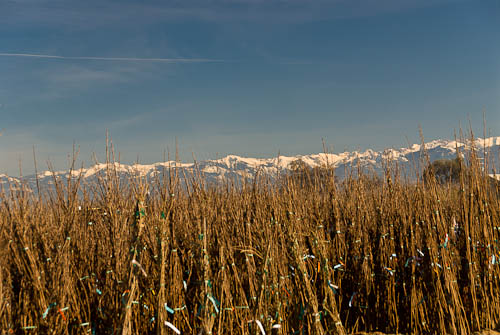
Trees in sand beds ready to pull for shipping.
I took the opportunity to escape the "War Room" where we line up and route all the trucks. I needed to rush some last minute order additions to the yard to pull for today's loads. Yes - we do add to your order right up to it getting on the truck. A few minutes later I had to do it again and took the camera with me this time.
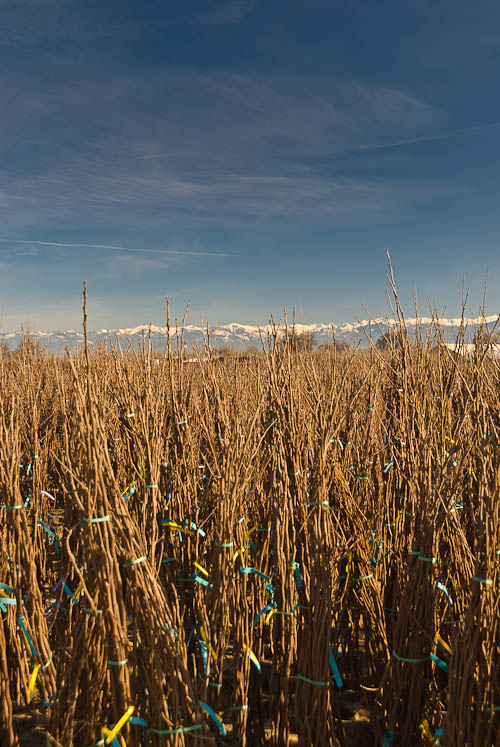
Persimmons in sand heeling beds. Snow capped Sierras in the background.
Needless to say, the urge to stay at the yard and pull trees was pretty strong just to enjoy the day. Sorry to those of you in the blizzards and ice storms - there really are some redeeming reasons to live in California (and some reasons not to as well). I expect fog will be on tap for tomorrow. Today was just a teaser.
Ron Ludekens 1-12-2011
Harvest Is Complete
This was a sweet sight.
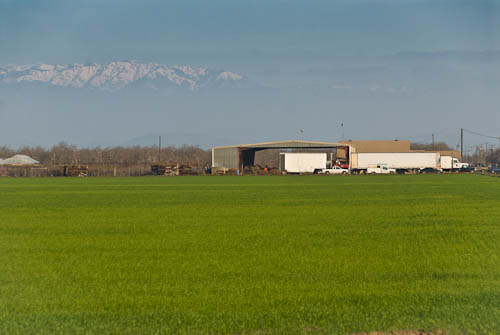
Shipping Dock, Trucks Loading, Snow on Sierras, Winter Wheat Cover Crop
Sun is out, rain is gone (for the moment) and even the fog has cleared - which usually means more rain is imminent. There are two things I like about what is shown in these images (besides the snow on the Sierras):
1) The winter wheat (cover crop on our rotated land) looks beautiful and healthy. Not many days ago this field was completely under water from the record rains and it was not one we had the luxury to pump as the harvest fields had priority. Our sandy loam really does drain well.
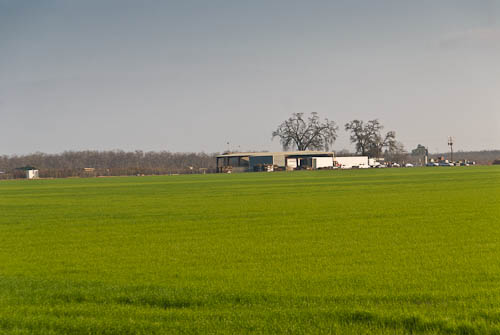
Cover crop of Winter Wheat. Field was under water a little over a week ago. What a little sun will do!
2) We are loading trucks. As fast as humanly possible. When you have been growing a crop for 3,2 and 1 years, it is nice to finally get it shipped to pay for the efforts. We finished harvest Saturday afternoon and got 12 trucks loaded Sunday. Wanted to get 18 out over the weekend but that assumed we finished harvest by Friday night but just did not have enough daylight hours to complete. Now the challenge it to ship 2 weeks worth of shipping in 1 week. We are hiring another 20-25 people Tueday to boost the efforts. Loading crews worked to Midnight (don't like all the overtime - but needed their efforts to get more pulled during the daylight hours.). Will likely do that most of this week (ouch).
The reality is we cannot catch up 2 weeks of shipping in 1 week. Will get close (maybe 1 2/3 weeks worth) but cannot make everyone happy.
Catch 22 - Delimma of Harvesting Time Sensitive Crops
If you read previous blog entries, you know the challenges record setting rain presented half way through harvest. Ideally we would have waited until the fields dried sufficiently to finish harvest. The bareroot crop does not have that luxury. Holding dormancy is not the problem - a few weeks delay would be fine. Our customers who sell the bareroot trees, have advertising breaking for the weekends, fruit tree clinics and pruning demonstrations already planned - these good people cannot wait.
So we decide to dig. Our workers put in heroic efforts in very uncomfortable conditions to make it happen. Here are some extreme shots of what the low end of the most difficult field looked like after the digger tracks and 4WD tractors turned it into mud soup.
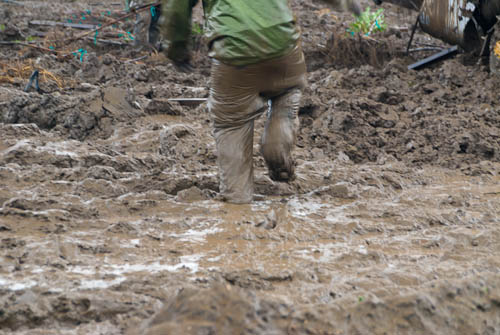
The turning/low end of the field. One foreman did not know when he lost a boot. Looks like the pants are in trouble here.
Thankfully where the trees are were not like this.
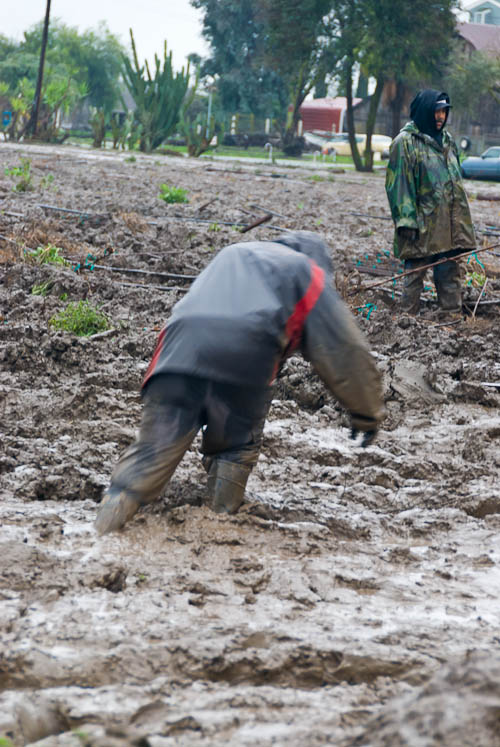
Mud Bath Anyone? I hear it is good for the complexion. Low end of field where diggers chew it up turning.
The middle of the fields where the trees were got a little muddy at the surface (not like these extreme shots) and the root section were surprisingly dry. Damp as desired and dirt still shook off in the digger shakers. But the top 3-6 inches got pretty sloppy. Workers got muddy lifting the trees into the trailers and wet from daily rain. Miserable working conditions. Trees don't mind.
Where the decision to finish harvest took its toll was in the shrubs and some June Bud fruits where sloppy conditions caused split roots and we dropped counts. Had to trim orders and adjust sizes. Tough decisions. Dig with some expected damage or not ship at all? We dug and now trying to make up time.
Speaking of time - it is after midnight for the 5th night in a row and I need to go get some sleep so I can meet tomorrow's challenges with a smile.
Ron Ludekens 1-10-11 (actually 1-11 now)
Rains Delay Deliveries
Someone forgot to tell Mother Nature that this is supposed to be a La Niña weather year. You know - drought conditions for the West.
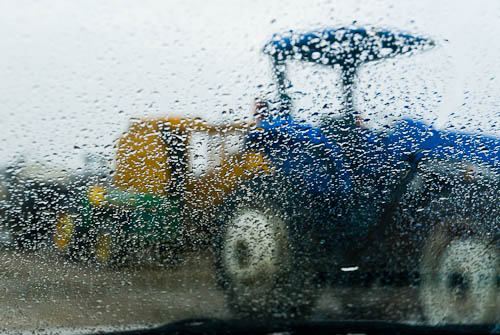
Digger and Tractors sitting idle this morning after night of heavy rain
It rained again last night and this morning. Heavy. Added over 1.25 more inches as of this morning. The rainfall total is over 500% of normal - breaking the all time record for the Month of December - and that all happened in the last 12 days. I would not be surprised if we matched the average annual rainfall in that period of time. We were getting close before last night.
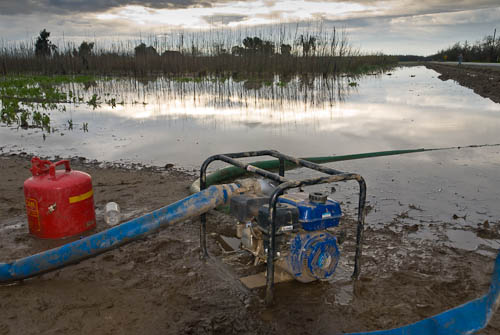
Wanted to start digging this field today but used 4 pumps to drain it instead.

One of four 4" pumps draining the field
Needless to say harvest has been slowed. The main rain event which hit us starting Friday 12/17 kept us pumping fields for a number of days. But we were back digging by Thursday 12/23 with relatively decent conditions - a little sloppy at the low ends of the fields where the diggers tear the ground up turning. The trees came out clean - the water penetration was not sufficient to turn the soil to mud at the root level. We dug full bore 12/24, took Christmas off (and it rained a bit) and dug Sunday through Tuesday at a fast pace.
But last night we got clobbered again. The soil is no longer thirsty and the fields will be slower to dry out. When a field is chewed up by the diggers, the water does not run off to the ends but sits and soaks. This makes for a most difficult quagmire to dig in when you go back to complete the field. When a field is not touched by a digger, it drains well and we can get back to it faster. We have almost all the edible fruits out of the ground with a few exceptions for late dormancy items. We have two fields of shades and ornamentals untouched by diggers which will be the first to tackle when dry enough tomorrow or Friday.
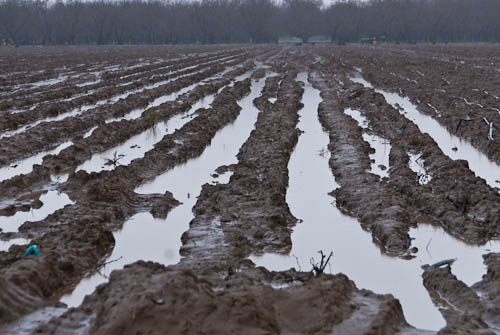
Yesterday we finished digging the grapes off this field while it was dry. Digger and tractor ruts capture the overnight rain water and the field will not drain. Where it was dug becomes a muddy mess so you do not want to have to go back and dig near there again. What we have left to dig does not have this problem - we planned it that way from experience.
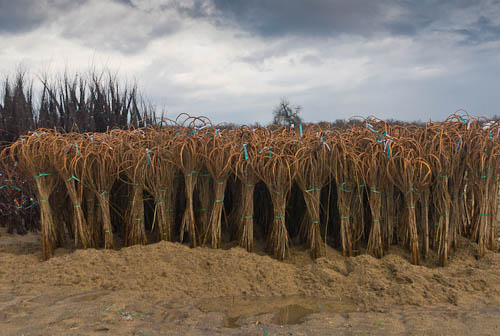
Harvested trees happily healed into sand. They like this weather.
Delivery Delay
Our goal was to have trucks on the road delivering Monday 1/3. It will not happen. I am hoping we can still be delivering by Monday 1/10 - a week late. I apologize to you for any inconvenience this may cause. Trust me - I want the trees in your hands more than you do so you can have the most amount of time to sell them. I've read about the legal term "Acts of God" but figured our tame valley would be immune. I think this qualifies.
UPDATE
Heard the shouts from the front of the office to come see the rainbow. (Yep it kept on raining today). We have an old antique digger on the corner of our office property which is what you see below the rainbow. (Wish the power poles and lines were not there for a better photo!) I saw a full very bright double rainbow and others said it was a triple rainbow a few minutes before.
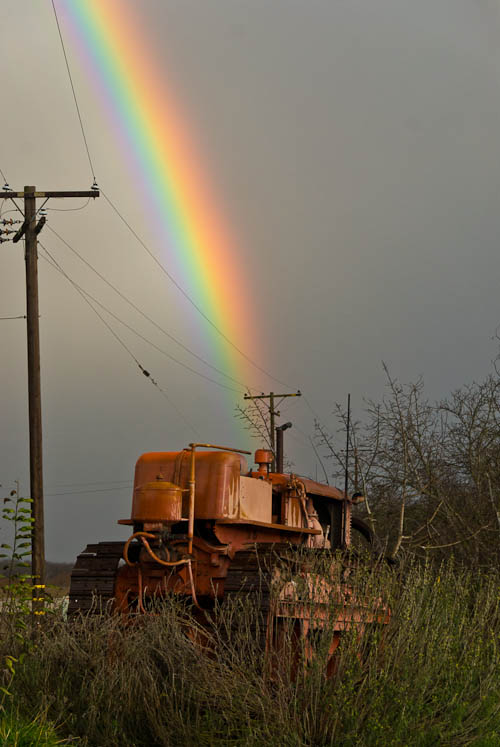
There is a Biblical precedence about the rainbow being a promise after the flood. Does this mean...?
Drove around before dark. Found it humorous that a flock of seagulls mistook our flooded (but thankfully empty) field for the ocean. They missed it by about 150 miles.

Seagulls mistaking our open land for the ocean
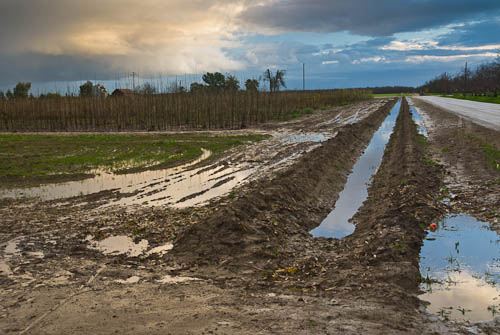
At 4:30 today: here is the same field that was pumped in the photo above - after a day of rain and pumping. The only water is sitting at the ends and sides in the tractor ruts. Rows are clear. We moved the digger here tonight to attempt to start digging it in the morning. I have my doubts...but we will try. If not, will dig on Friday.
More fun and mud to come.
Ron Ludekens December 29, 2010
Weeping Pussy Willow
Weeping Pussy Willow
I wanted to show you the Weeping Pussy Willow (Salix caprea 'Pendula'). Until this year, we grew them in a two year field and I think the general consensus was they were too light of a caliper even though shaped nice.
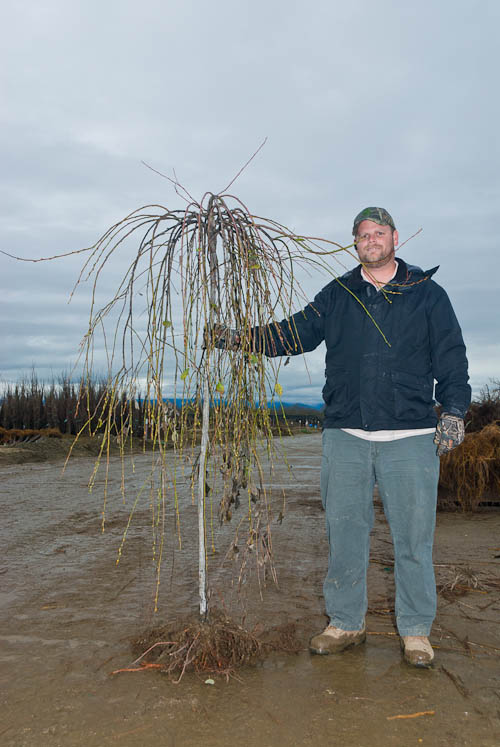
Phillip holding Weeping Pussy Willow from 3 year field
This year and from now on, they are being grown in a three year field. Take a look at this representative sample that Phillip is holding. Much more impressive. They were just harvested and we have quantities available.
Ron Ludekens 12-27-2010
Record Rains?
Record Rains Slow Harvest
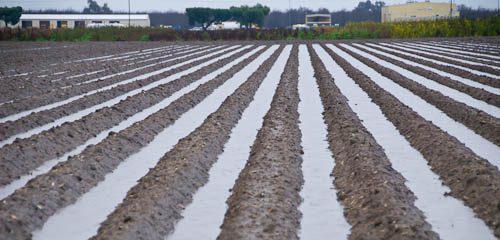
Next Year's Seedling Field
Twas the day before Christmas and all through the fields...people are working - finally after a water logged week of near record rains.
I'm sure you saw it on the news. The West Coast was hammered with the "Pineapple Express" - heavy rainfall originating from the tropics. It started for us on Friday afternoon 12/17 and continued heavy until Tuesday with lighter rains on Wednesday. Now it is hitting Southern California with a vengence while we dry out.
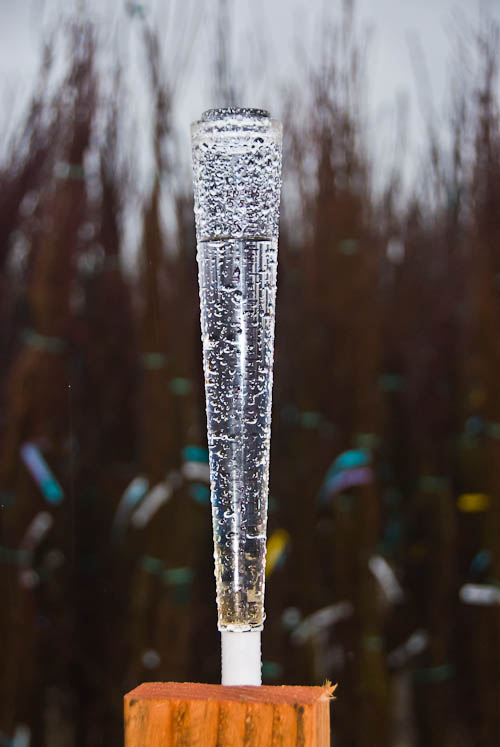
From Friday night to Monday morning 4 1/2" - add another 1" Monday and Tuesday.
Now for many of you reading this, 5+ inches of rain is nothing. But for the flat Central Valley of California, where 9" of rain is the whole year's allotment, this is considered a flood. There is no place for it to run off quickly.
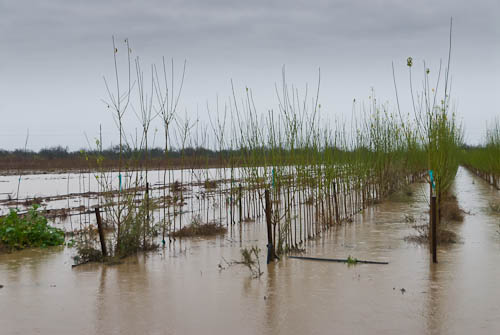
Cooke 2 Field - partially harvested on the left. Flowering Apricots in foreground.
The photos of the fields on this page shows what I saw Monday morning. At first look it was pretty depressing. Every year we usually have some rain that requires pumping excess water off the low (drain) end of the field. So we have large portable pumps for that purpose. This rain event was no different except a lot more water to pump off. Thus we ran out an bought 5 more expensive pumps to take care of more fields at once. By Monday afternoon, even though it was still raining hard, the sitting water was gone. Pumped water off again Tuesday and Wednesday mornings after the night time accumulations. Our guys worked hard and the fields drained very well. Just needed a little dry time to get the diggers back in.
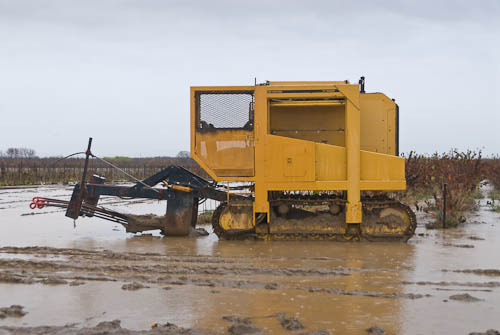
Digger Monday morning shows water not deep - just not suitable to dig either.
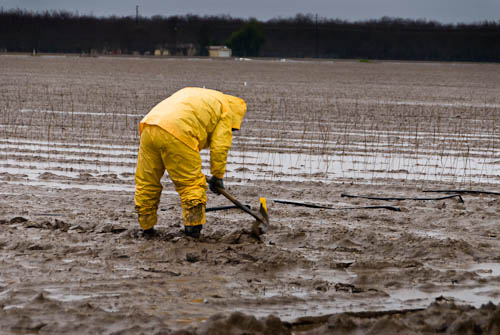
Employee cutting paths for water to drain better to pumps. This field of seedlings/cuttings was just planted in late November and will now have to be sprayed to prevent water borne diseases that love to attack seedlings. Lot of extra cost to be expended to have this crop 2 years from now.
By Thursday afternoon, we had the diggers back running in the fields and full day of digging Christmas Eve with multiple diggers. Did I mention we are growing on great sandy loam soil? Water penetrates and disappears quickly. Glad this is not a clay based profile.
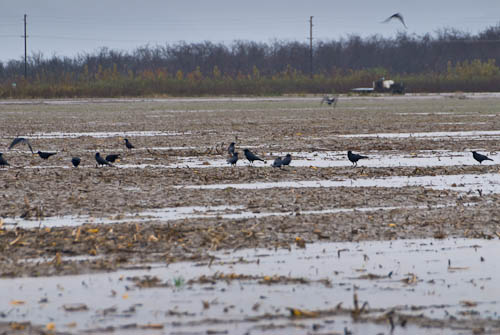
Emply field where we took the corn cover crop off last summer. Crows are appreciating the worms and other critters coming up for air.
In agriculture, you have to deal with what Mother Nature throws at you and this is one of those challenges. I think we learn to look for silver linings in things. For one, California needs the water (just not all at once please!). Second, we are hoping all the gophers in our valley drowned. Some of their holes made great drains for a while.
Today, we received delivery of the last 3 remaining large "Mudder" tractors found in our Valley.
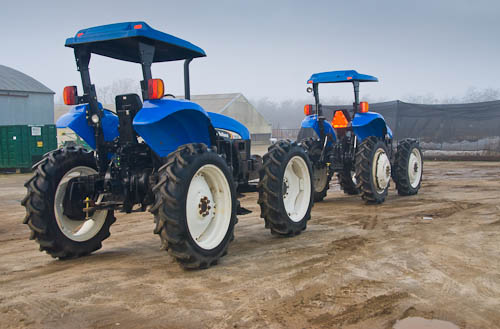
Rental "Mudder" tractors arrived for pulling trailers. Won't be clean very long.
We have a lot of tractors but the 2 wheel drive versions will no longer be able to pull trailers full of trees through the muddy digger ruts in the fields. We have a few large and smaller 4 wheel drive tractors as well. The smaller ones are worthless when their bellies drag in the mud as the wheels spin in the digger ruts. So we have rented these 3 extra high clearance tractors to pull the trailers to the edge of the fields where the other tractors can attach and pull the trailers on the roads. $1,800 a month lease for each one - an expense we would like to not have had to expend.
Bottom line is we have lost some harvest time and will likely run a week later than planned for shipping. We have a great crop in the field with over half already harvested and in the sand beds. Those in the field are in great shape as well and will be harvested in fine shape although with more expense and labor to get it done. Our goal to start shipping right after New Years weekend will slip by the week we lost with the rains. More storms are forecasted for Christmas night and again later next week. If only normal rains, should not stop harvest (but will break local records for rainfall in December). Hurrah for Sandy Loam!
Hope you and your family have a Merry Christ's Birthday. I know I am looking forward to our family gathering and the last day off from work for several weeks to come.
Ron Ludekens 12-24-2010
Rooted Blackberry Tips
Rooted Blackberry Tips
What are "Blackberry Tips"?
This question comes up whenever we offer some for sale and it is important to understand the difference between rooted tips and a one or two year plant. I took some photos to help:
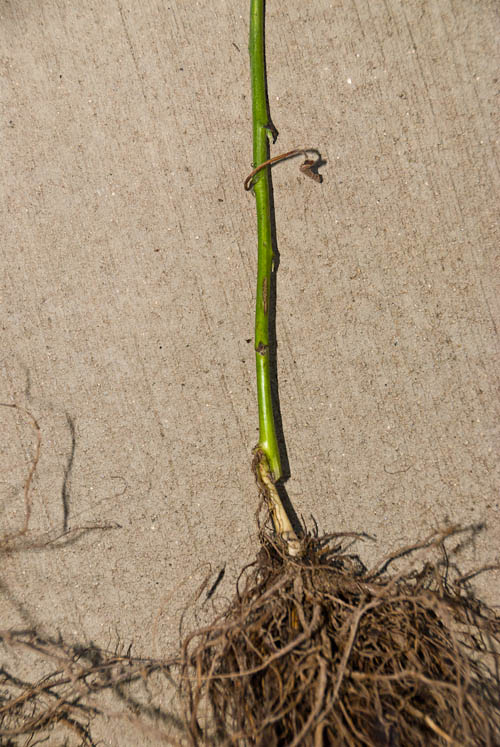
Rooted Blackberry from "Tipping"
A common method of propagating new Blackberry Plants is by "Tipping". We take a "Mother" plant's long canes and bury the tips in the soil at the appropriate time of the year. A few months later the cane can be cut off and where the tip has rooted a new plant will arise.
This is how we grew our blackberries and Black Cap raspberries for most of our history until recently when our greenhouse facilities were expanded to handle additional propagation. In the photo above, you can see a typical blackberry rooted tip. If you plant this vine, it will root and send up new canes. All sounds normal - right?
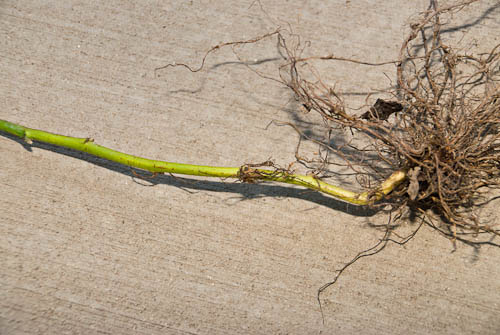
Look closely at the bud eyes. They are upside down - pointing at the ground, not at the sky like a normal plant would. This original cane from the mother plant that was essentually rooted upside down will die back to the roots. The roots will send up new canes.
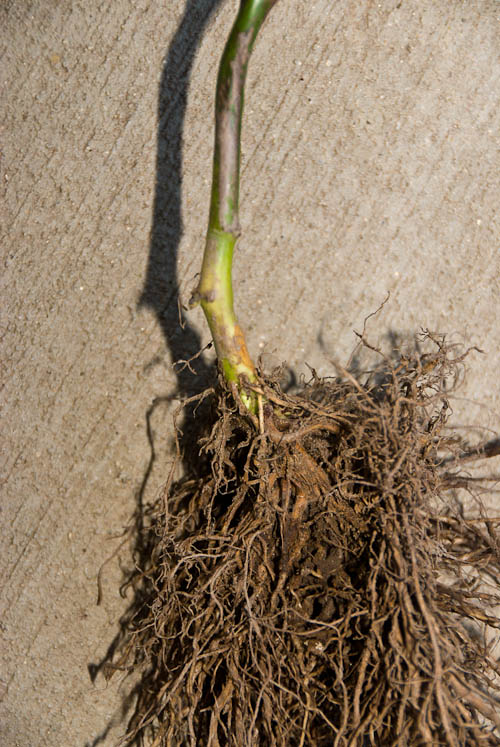
You can see the bud eyes near the roots that will send out new canes from this rooted tip.
We now grow the blackberries in propagation pots and then plant them in the fall. A year later we harvest nice mature vines. This gives us a well rooted plant started in the propagation container plus a plant that had a year in the field. Plus we get better accuracy in inventory counts knowing how many we plant minus a small loss factor whereas tipping was very hard to count.
With the demand for berries climbing so rapidly, we decided to tip some varieties this year and offer the rooted tips at a lower price to those who are looking for berry plants and willing to work with the tips. As I mentioned above, these are how we used to grow all our berry plants and can still be found in many catalogs of berry growers across the land.
Ron Ludekens 12-20-2010
Low Budded Flowering Cherries - 3 Year
Three Year Low Bud Flowering Cherries
The L.E. Cooke Co grows Flowering Cherries several different ways. For many years they were only grown as "Top Grafted" on Mazzard (Prunus avium) rootstocks. Everyone is familliar with the top grafted Weeping Cherries like the double pink flowered Prunus subhirtella 'Pendula Rosea'. We also top graft almost all the upright flowering cherries as well. For some reason that was the expected form for the ornamental gardens of the west coast and we provided quality trees in this form for years.
When we started growing them budded at the ground to meet that other demand, we grew the weeping ones in a three year field to get the height but everyting else in a two year field. I was not satisfied with the size and caliper of the ones from the 2 year fields for our landscape orientated customers. So we moved most to the three year fields and now I want to show you what you can get.
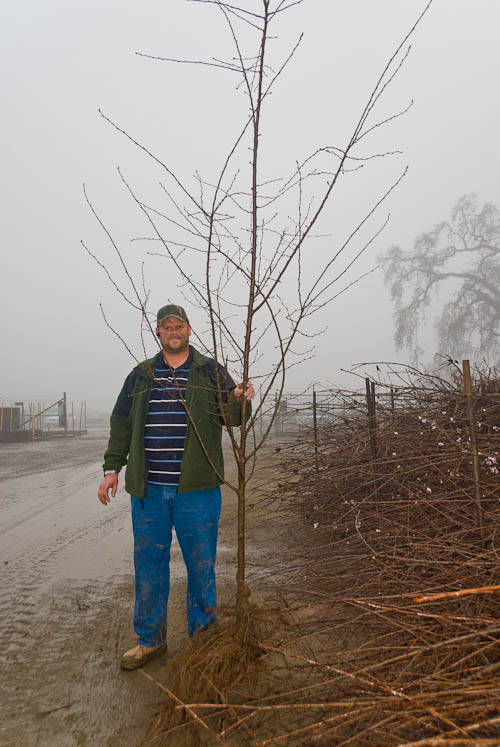
Beni Hoshi 3 Year Low Bud
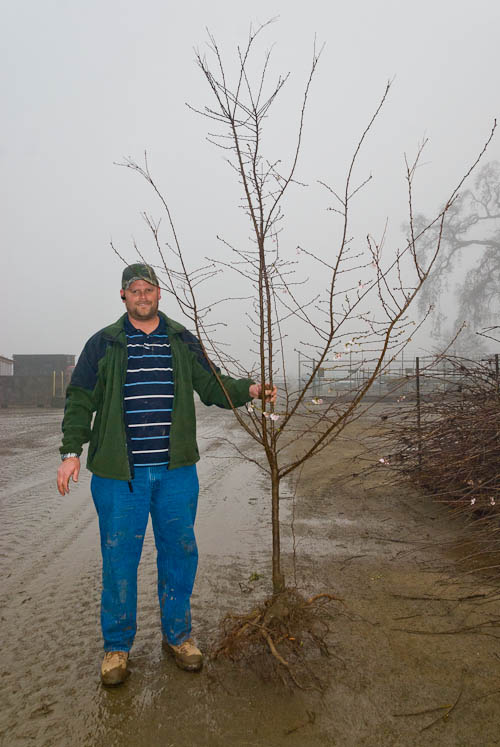
Autumnalis 3 Year Low Bud (Notice some fall bloom)
One of the advantages of low budded flowering cherries is the branches help provide shade for the trunks from the hot summer sun. If you live in a hot summer area like ours, the top grafted cherries will get sunburn on the trunk which is why we whitewash the trunks. Not so on the low buds.
I also want you to compare the low budded Weeping Cherries with the Top Grafted Weeping Cherries. Most of us in the office prefer the Low Budded Weeping Cherries because they have weeping branches all up the trunk - not just at the top.
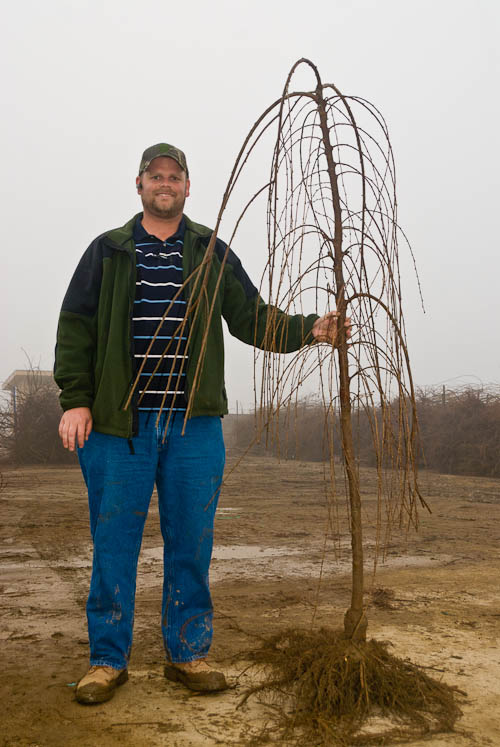
Low Budded Snow Fountains - notice weeping all the way up the trunk (Phillip is 6'3" for comparison)
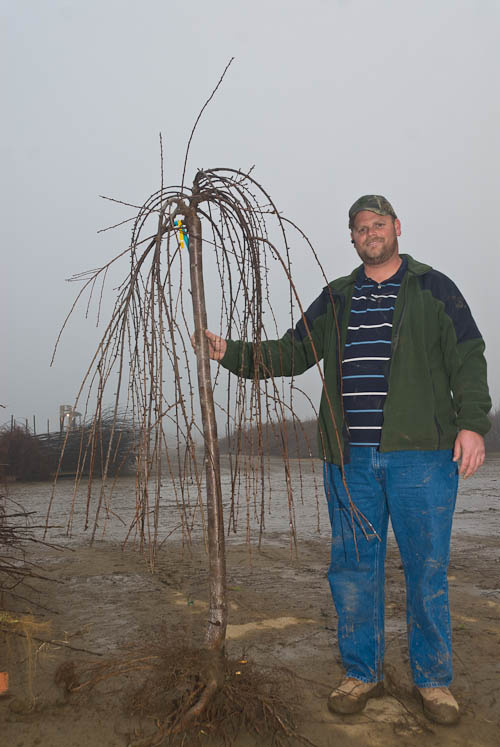
Top Grafted Snow Fountains from 3 year field
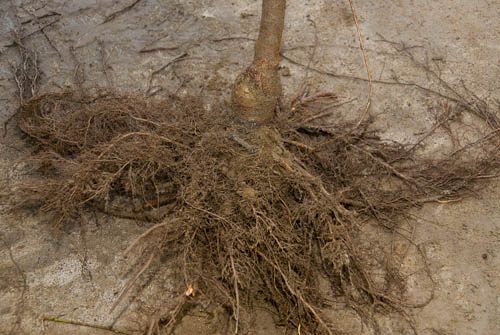
Root system on 3 year Flowering Cherry

Low Bud Snow Fountains planted by the entrance to my daughter's home
We have a very nice harvest of low budded flowering cherries with large calipers and good heads - both weepers and uprights.
Ron Ludekens 12-17-2010
Yard Bareroot Processing in Fog
Perfect Tree Weather
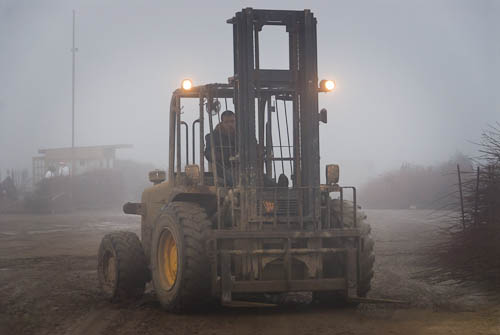
Forklift in Processing Yard in Mid Morning Fog (9:30 AM)
Fog. It can be depressing and cold for workers (or people in general) but the bareroot trees love it This Central Valley of California is famous for its Tule fog from late November through mid January if we have any rain soaked ground to fuel it. Today we have fog big time although weatherman predicts a week of rain starting tomorrow with hints of needing Noah's Ark. No risk of drying out the roots!
It is the fog that helps makes this Valley one of the richest agricultural regions in the world. It is the fog that creates all the great chilling hours that fruit trees need and also holds back the night time freezes.
For example, a fog free 24 hours will typically see 24-26ºF at night but warm quickly to a sunny 70ºF in the day. Many of the chilling hours are offset by the heat of the afternoon. But a foggy 24 hours will have lows in the 33-35ºF and highs in the 36-38ºF. Combine 20-30 days of fog during the winter and the chilling hours below 45ºF really add up. Simply stated, we can grow almost anything deciduous here which is why so much of the country's edible fruits and nuts are harvested in our back yard.
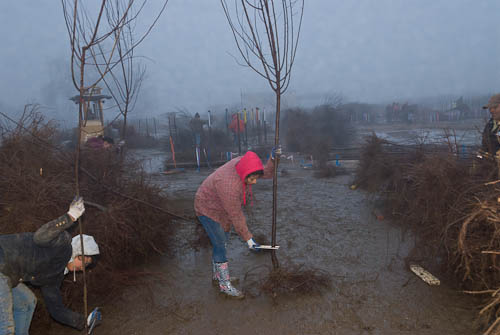
Woman Employee Grading & Caliper Sizing Trees
I thought it might be interesting for you to see the efforts our employees put into providing quality trees in a timely manner. Timely in the sense that they all work in winter-like conditions to get the trees out to you starting in early January. Here you see one of the grading crews sorting the trees between the "keepers" and the trash pile and then measuring the caliper before placing them in the appropriate size pile.
Over the years we have found more and more women in our work force as we automated some of the haevier tasks like digging and tying. They have proven to be excellent and efficient graders.
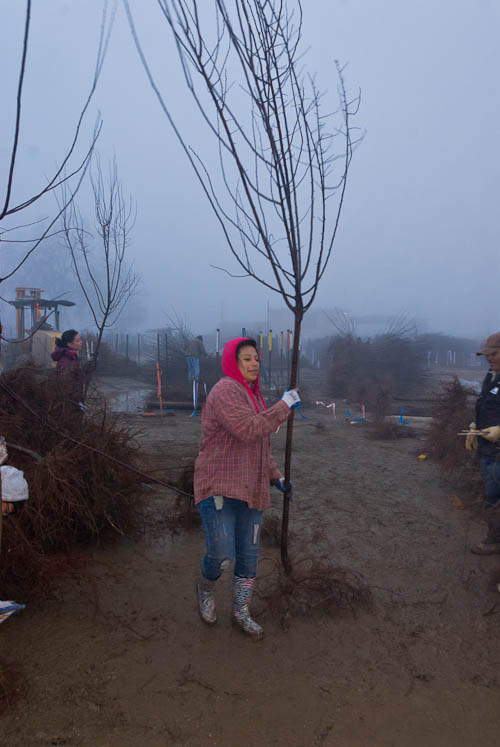
Grading is not necessarily light work. Handle thousands of trees each day and I'll bet you sleep well at night.
We have 7 large grading/tying/labeling areas plus we can use the covered shipping dock to keep a small portion of the crews dry in incliment weather.
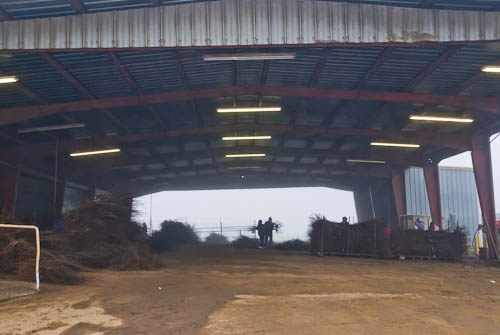
Shipping dock can be used as a grading/tying area in the rain.
Fortunately we do not normally have a lot of rain in December and fog is not much of an inconvenience unless you are driving. Someday we hope to rig or build structures to keep the rain off a larger portion of the processing yard.
Big week of storms start tomorrow - hope the weatherman is wrong about 3-6 inches of rain in the week ahead. That would be 1/3 to 2/3 of the annual 9+" of rain. This flat valley would be saturated and digging trees a muddy mess. More to come.
Ron Ludekens 12-16-2010

